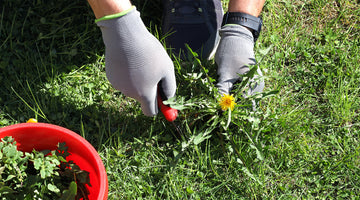Weeds are the loud and obnoxious guests who accidentally received your family BBQ invitations, now proving to be stress-inducing and exhausting to remove from your backyard. Most weed killers contain chemicals and herbicides that harm the environment and your lawn’s long-term health. Here are six eco-friendly tips to help you maintain a (nearly) weed-free lawn.
Have a consistent and strategic mowing schedule
A healthy lawn is thick and relatively long, which is crucial in limiting weed growth and preventing spread. Cut the grass every 4 to 8 days during the fast-growing months of spring and in the fall between every 10 to 14 days until the grass stops growing. The ideal height for cutting grass is 7.5cm (3in.) because it will strengthen the roots and build the grass’s food reserves allowing for a healthy lawn ready to block potential weeds
Aerate your soil
Do this twice a year. The process will create holes to prevent the ground from being compacted, allowing for direct airflow and a place for water and necessary nutrients in the soil. Another tip to help avoid compacted soil is to have occasional days where you limit the amount of foot traffic and activity in specific areas on the lawn to allow it to rest and restore. The increased nutrients in the lawn will encourage grass growth that will choke out the weed threat.
Be a watering expert
Three times a week, totalling 2.5cm (1 in.) of water. This will allow the water to go deep into the roots to nourish the grass but avoid over-watering, so you don’t starve the soil of crucial oxygen and risk diseases. You can place a small tuna can (or similar-sized container) on your lawn and turn off the sprinkler when the can is full. This watering technique encourages deep root growth limiting the risk of weeds and giving fewer weed seeds a chance to sprout.
Feed your lawn what it needs
Organic fertilizer is an environmentally conscious way to encourage a thick, long and healthy lawn, and we suggest our special formula slow-release blend to prevent burning patches of grass. Compost, made of decomposed organic plant matter, is a great natural food to spread over your lawn. Do not bag your fresh grass clippings as they provide 30% of the fertilizer needed by delivering nutrients to the soil and lowering the ground temperature, which reduces watering. This approach creates a thick law and healthy soil, both are vital in preventing weed growth and spread.
Create a biodiverse lawn
Moving away from a traditional lawn by having one with a variety of plant species is an underrated strategy for fighting weeds. Your lawn will be more resilient against weeds by having various species of grass, a diverse selection of shrubs, and several ground cover plants. This strategy will inhibit weed growth while creating an appealing aesthetic. You can also over-seed sparse patches on your lawn to promote heavy grass, which leaves less room for weeds to grow.
Do a weekly inspection of your lawn
The above strategies will keep your lawn in great shape, but weeds can be evil ninjas with a few sneaking in. Weekly lawn inspections will allow you to spot a weed you can manually remove before it spreads. You can also contact us to test your soil to determine its pH levels (acidity) and to discover any potential issues that need to be addressed.





